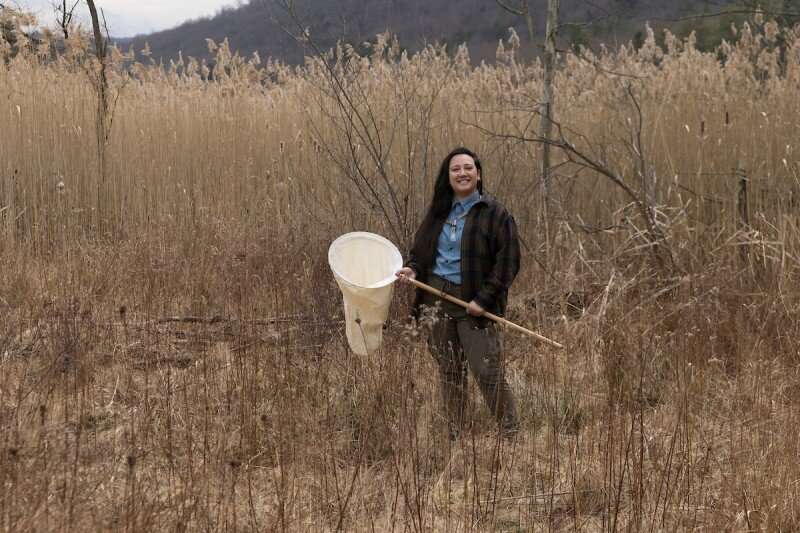This article has been reviewed according to Science X's editorial process and policies. Editors have highlighted the following attributes while ensuring the content's credibility:
fact-checked
peer-reviewed publication
trusted source
proofread
Research highlights the role of ants in forest regeneration

Walk through an old-growth forest in early spring, and you'll be dazzled by wildflowers, their jewel-like tones shining from the forest floor.
But in newer forests, spring ephemerals such as trillium, wild ginger, violets and bloodroot are in shorter supply. The reason may lie with some less-flashy forest residents: Aphaenogaster sp., or the woodland ant.
"Not a lot of people have heard of them, but they are the powerhouse of moving seeds and called 'keystone dispersers,'" explained Carmela Buono, a Binghamton University doctoral candidate in biological sciences.
Buono is the lead author of "Historical forest disturbance results in variation in functional resilience of seed dispersal mutualisms," recently published in Ecology and co-authored with Binghamton University Assistant Professor of Biological Sciences Kirsten Prior and undergraduates Jesse Lofaso, Will Smisko, Carly Gerth and John Santare. Together, the team measured understory plants and seed dispersal by ants in 20 New York state forests, half old-growth and half-regenerated.
More than 95% of New York state forests—including the Binghamton University Nature Preserve—are secondary forests, which have sprung up on land once cleared for agriculture. While parts of these regenerated forests, such as the overstory, have recovered well, they are missing other aspects of biodiversity—particularly when it comes to understory plants such as native wildflowers.
Many plant species rely on a mutual relationship with ants to disperse their seeds. In fact, northeastern North America is one of the major hotspots of ant-plant mutualism, although it also happens in parts of Europe, Australia, South Africa and in northeastern Asia, Buono said.
"These plants evolved with seeds that have an appendage rich in fats attached to them, and that's very attractive to woodland ants," she said. "Ants need fats just as much as protein and sugar, and it's hard to find foods rich in fats in the forest."
Shiny black and medium-sized, woodland ants are a native species that lives in logs, forest leaf litter and underneath rocks. Woodland ants take the seeds with fatty rewards back to their nests, protecting them from consumption by rodents and other organisms. Once the fatty appendages are consumed, the ants—in a kind of insect housekeeping—remove the seeds from the nest, dispersing them far from the original plant. It's a mutually beneficial arrangement.
"There are so many interesting, intricate parts of this interaction depending on the types of seeds ants prefer, so you can get this beautiful mixing of flower species in forests," Buono said.
How are old-growth forests different?
old-growth forests are rare treasures that play an important role in preserving species diversity, Buono pointed out. Pockets of the Northeast's ancient forest cover remain in some areas, often on land deemed unsuitable for farming.
They differ from secondary forests literally starting at the ground level. Ground previously cleared for agriculture is flat, whereas old-growth forests have a "pit and mound" topography.
"It's uneven, from years and years of trees falling over," Buono explained.
The pits are left from the roots of toppled trees lifted out of the ground, while mounds result from the extracted root and soil. Species within the two types of forest are also different, with quick colonizers moving into younger woodlands. An established forest often features a greater number of shade-tolerant plants in the understory.
There are slightly fewer woodland ants in secondary forests, perhaps owing to their displacement during years of agricultural use. Differences in forest canopies and the amount of light that reaches the forest floor could also play a role, but that has yet to be explored, Buono said.
The real issue appears to be competition with invasive slugs, which are found largely in the regenerated woodlands and also have a taste for fatty seed appendages. Slugs often prefer forest edges, and secondary forests may be located closer to habitats that slugs prefer, such as open meadows or active farms, Buono said.
To restore newer forests to a healthier state, we need to look beyond the trees to the diversity of insects, which play a crucial role in the forest ecosystem, according to the researchers.
"Ants are beneficial. They're not as charismatic as butterflies or bees that help pollinate flowers, but they are just as important," Buono said.
More information: Carmela M. Buono et al, Historical forest disturbance results in variation in functional resilience of seed dispersal mutualisms, Ecology (2023). DOI: 10.1002/ecy.3978
Journal information: Ecology
Provided by Binghamton University

















